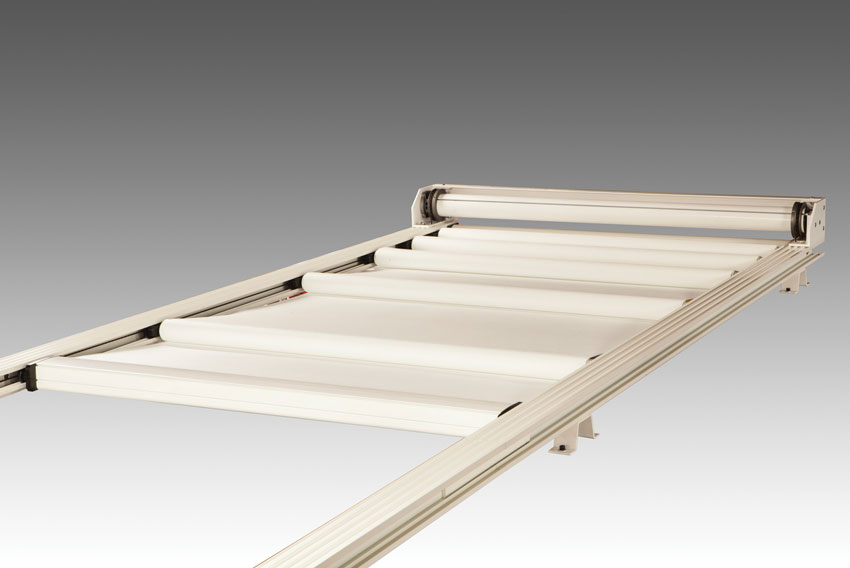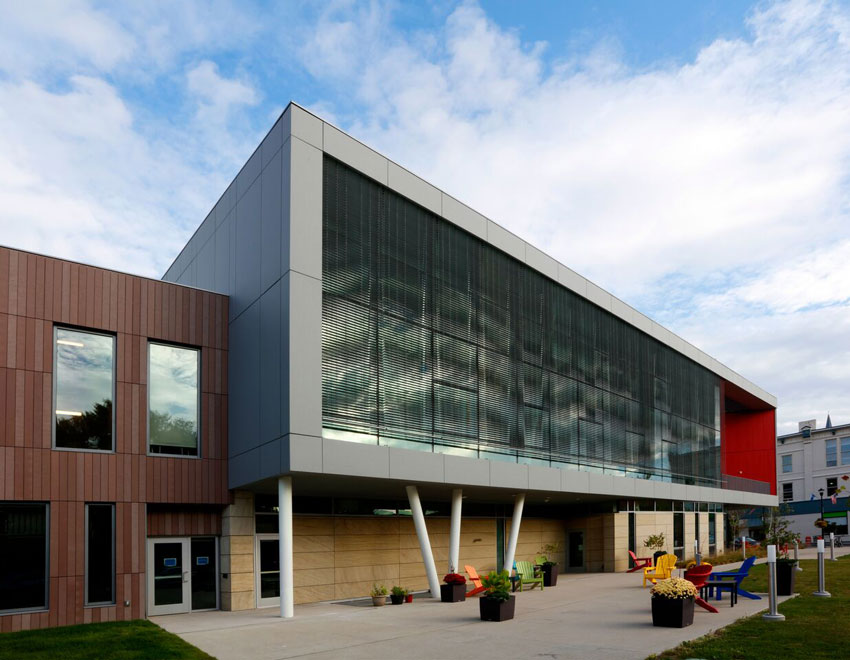Understanding the Benefits of Interior and Exterior Shading Systems
The main issue to be addressed was the fact that the shading systems needed to draw to the vertical facade glazing, which could not be subject to any tension loads. This meant that a cable-guided tension system with return pulleys that connected to the building structure could not be used.
Two main options were considered: a retractable system comprising a series of fabric panels that are mounted onto spring roller tubes (retractable fabric panels) or a more standard-fabric tension system with side guides incorporating return pulleys. Of the options, Grimshaw preferred the appearance of retractable fabric panels and thought it worked well with the architecture of the building, especially if the spring roller tubes could be aligned with the skylight structure above.
The broad construction of the retractable fabric panel system is as shown in the schematic below. A drive tube, incorporating a tubular motor, is mounted onto the two side tracks of the system. Running between the side guides is a series of spring roller tubes which are connected to wheeled trolleys that run in the side tracks. Two fabric panels are mounted onto each spring roller tube allowing the panels to be connected to the adjacent spring roller tubes, creating a continuous system when it is deployed. The drive tube has cord spools on each side; the cords run inside the side guide tracks, around pulley wheels and connect back to a hem bar that is attached to the first fabric panels. When the motor is operated, the cords pull out the hem bar, which in turn starts deploying the fabric panels. When the motor is reversed, the spring roller tubes wind the fabric panels onto them, retracting the system.


Images courtesy of Draper, Inc.
Shown is a schematic of the retractable fabric panel system used at the Richard H. Broadhead Center for Campus Life on the West Campus of Duke University.
A potential issue with the retractable fabric panels is that the size of the retracted package is quite substantial, as it incorporates both the drive mechanism and the retracted spring roller tubes. However, the building design allowed a pocket into which the system could be installed. The limited draw of the systems (approximately 11 feet) meant that the retracted package was not too large and that an overall pocket dimension of 13 inches deep by 12 inches tall was sufficient. This amount of space was available.
The other issue to address was that although the system pulled out horizontally, the drive mechanism needed to be set to an angle of 4 degrees from horizontal because of the slope of the roof glazing. This was not an issue with retractable fabric panels.
The key design requirement was the coordination with the ceiling and support structure to ensure that the size of the pocket was sufficient to hide the system when fully retracted and also allow the installation of the system and access for any subsequent maintenance. Once this was resolved, it was possible to manufacture and install an elegant and effective shading system.
There are many examples of projects that required specialized solutions to complex shading problems. Another example is the Gateway Center Hotel at Oberlin College, which utilized exterior venetian blinds to help with proper daylighting and shading.
The Gateway Center at Oberlin College is a mixed use building incorporating guest rooms, event and conference spaces, a welcome center, farm-to-table restaurant, and the College’s administrative offices. The intention of the architects, Solomon Cordwell Buenz (SCB), and the college was to create a highly sustainable building that would become only the fifth new hotel in the United States to achieve LEED Platinum classification. Additionally, the aim was to achieve net-zero energy consumption and net-zero carbon production.
To achieve these aims, the design incorporated a range of innovative features, including radiant heating and cooling, geothermal power, photovoltaics, rainwater collection, a thermal envelope with rainscreen technology, natural ventilation, and automated exterior venetian blinds. Measured by energy use intensity, the building is expected to be among the top ranking commercial structures in the United States, using 55 percent less energy than comparable buildings.
Because of the benefits of exterior shading, the architects decided to include long-drop venetian blinds on the west-facing elevation of the event space as well as exterior venetian blinds for the hotel bedrooms. As part of the discussions about the project, a shading analysis was conducted to look at the performance of the shading for the hotel bedrooms. Eventually, a decision was made to move to interior shading in these locations, but exterior venetian blinds were incorporated into the design of the event space. The blinds allow views to the outside while providing effective solar control, reducing interior heat gain and contributing to the outstanding energy performance of the building.

Photo courtesy of Draper, Inc.
Exterior venetian blinds were installed on double-height west-facing glazing to provide occupants of the Hotel at Oberlin with outside views while also providing effective solar control.
Custom-Designed Solutions
While there are many ways to incorporate shading into a space, including off-the-shelf shading systems as well as modified products and specialized solutions, these may not meet architectural requirements in every situation. In such cases, a custom-designed solution that is specifically developed for the project might be the best approach. Custom solutions are generally developed from scratch to meet the specific requirements of a project.
The main aim is to develop a system that effectively addresses the control of natural daylight and solar gain. It is important, however, that the system also meets the design intent in terms of aesthetics and integration with other building components while meeting the budget constraints of the project. Budgetary constraints largely preclude the possibility of developing a custom system for a small project. It becomes feasible, however, as the scale of the project increases.
The Canadian Parliament West Block Rehabilitation Project is an excellent example of how a custom operable louver system provides a daylighting solution.
The Canadian Parliament Building complex in Ottawa is currently being refurbished. The project was started in 2002 and will continue until at least 2023. From around 2019, the main Centre Block of the complex, which houses the legislative chamber of the Canadian parliament, will be closed for a five-year-long renovation. Prior to this happening, the West Block was renovated and the courtyard converted into a legislative chamber that will be used while the Centre Block is out of commission.
The conversion of the West Block courtyard included the installation of a multilayer roof structure comprising a supporting steel structure, outer glazing, a louver system to provide light control, an access catwalk, and an inner laylight. On completion of the work, the temporary House of Commons will have a stunning roof structure while maintaining many of the original courtyard features.
The proceedings of the House of Commons will be televised so the control of light through the roof structure is critical. To achieve this, an adjustable louver system was required to allow ambient light into the chamber while preventing direct sun penetration.
The operating requirements for the louvers were established by the climate engineering company Transsolar. Among other things, the control specification set out the need for the louvers to be able to rotate through 180 degrees to allow the system to track sun movement throughout the day from sunrise in the east to sunset in the west.
Given the complex geometry of the roof and the need for 180-degree louver rotation, it wasn’t possible to use a typical solution. As a result, the solution provider worked closely with the facade engineers, Front, as well as Transsolar and the skylight contractor, seele, to develop a custom system that would meet the highly specific project requirements.
All the components of the system were designed from scratch to address the specific project conditions. A key element of the design was the development of a drive mechanism to allow 180-degree rotation.
The final design included a drive bar with sections of rack mounted at each louver location. These racks engaged toothed wheels mounted on the louver shafts. Consequently, as the actuator drives forward and back, the louvers are rotated. Adjusting the actuator stroke allows the amount of louver rotation to be increased or decreased as required.
Two mockup systems were then manufactured and installed at seele’s facility in Germany. The mockup systems were reviewed by the design team and modifications to the design were made to address any issues.
To minimize noise generated by the system, alternative linear actuators were considered. Noise measurements were undertaken on the mockup in Germany, which resulted in replacing the original actuator with one that could achieve significantly quieter operation.
The mockup also allowed maintenance issues to be considered, including the feasibility of replacing louvers, replacing an actuator, and in the event of an emergency, closing a bank of louvers if an actuator failed.









